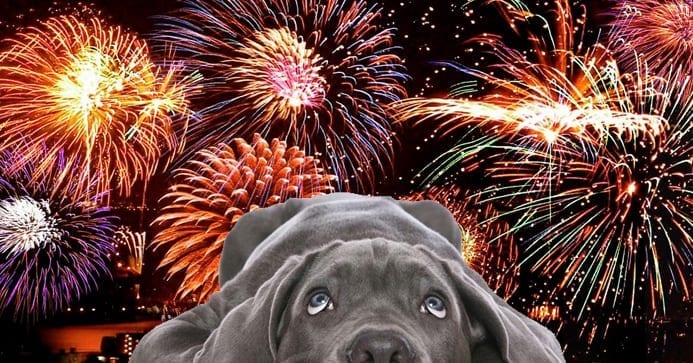
We may love going along to an impressive fireworks display at New Year, Bonfire Night or on the 4th of July, but for our canine friends, it can be one of the most stressful times of the year.
If you have a dog that does not bat an eyelid at fireworks be so thankful. A large proportion of dogs suffer some form of anxiety as a result of these noisy bangers. Whilst some cases are mild and can be managed with a few simple tools, some reactions can be extremely severe. These dogs may drool, urinate, become destructive or be so frightened they just can’t function.
It is not a nice thing to witness and it can take some dogs days, even weeks, to recover after being exposed to fireworks.
I have been lucky that all the dogs I have had have not been too fussed but I do know of some dogs, and their owners, that have a terrible time during fireworks season. I even know one who takes her dog and goes to a secluded island location just to save them the distress!
Fireworks may be fun for us but they can be a source of terror for our dogs
We have pulled together 11 tips for helping your furry friend manage during fireworks season.
1.Sound desensitisation
Be aware, if your dog has an extreme reaction to fireworks then this technique may need to be introduced VERY gradually, alongside other techniques and with the help of a qualified Behaviourist.
There are CDs, YouTube clips, Apps and mp3 downloads that are available that can help you work with your dog to gradually build up their tolerance levels of fireworks noises.
The Dogs Trust, the largest dog welfare charity in the UK, have a comprehensive sound based treatment programme on their website that we would recommend
With these desensitising techniques, the key is to build things up extremely slowly. The idea is that you introduce the sounds at an extremely low level and build up to a higher level very slowly, over an extended period of time. If at any point, you increase the volume to a level that results in your dog showing any signs of distress, you should go back a level and take it more slowly.
Whilst you are introducing these noises you should also accompany the sessions with some good distracting rewards. Offer them some tasty treats, treat dispensing toys, chews or a game of tug or retrieve. You want to start the counter conditioning process and have them associate the noises with positive things.
Some people introduce these desensitisation techniques from puppyhood. If you can work on it before they have an extreme reaction it can be great forward planning and will hopefully help reduce the chances of a phobia developing. It is scientifically proven that dogs that are exposed to new experiences in an appropriate manner during their key socialisation period, between 3 and 16 weeks, will generally adapt to them more easily going forward. This can be particularly useful for breed types that are known for being sound sensitive, Collies for example.
If you are introducing after puppyhood, be aware that, to increase the chances of success, you will need to start introducing this process months in advance of fireworks season.
Introducing your dog to a sound based desensitisation programme from an early age will mean you are reducing the chance of your dog developing a fireworks phobia at a later stage
2. Create a cosy and safe space
Make sure that your dog has the opportunity to go to a safe area. If they have a crate or a bed they usually go to make sure this is available. They may choose to go under the bed, into the bathroom, a smaller enclosed space. If they do, don’t try to force them out. Just make sure that you make their space as cosy as possible and try to stay close to offer comfort if they want it…
We recommend closing all the curtains, putting on the TV or radio to drown out the noise and give them as much reassurance as they want.
3. Distraction can work wonders
As mentioned before, by giving your dog a super tasty chew or treat dispensing toy you may find that you are able to distract your dog from the noises that are frightening them. If they have an extreme phobia though, they will be too frightened to engage and other techniques will need to be applied.
4. Comfort your dog – ignoring them is not good advice
Despite advice that you may receive to the contrary, comforting your dog in a stressful situation does not reinforce their fear. In fact, scientific studies have shown that comfort from an owner in an unfamiliar situation can help to lower their heart rate. So if your dog is seeking a cuddle, please do oblige. Withdrawing from them will likely only make them more anxious, especially if the normally get cuddles whenever they want them.
Some people may also suggest that you should take your dog along to a fireworks display and expose them to it as they “just need to get used to it”. PLEASE don’t follow this advice. You will likely make your dog even more fireworks phobic, you are forcing them into an extremely stressful situation and you could risk them bolting or lashing out due to the heightened levels of anxiety. Bottom line, it is just not fair.
5. Time your dog walks carefully during fireworks season
During the times of the year that fireworks are prevalent plan ahead. You don’t want to be walking a dog that is frightened by them at a time when they are likely to be going off, especially off-lead. The number of dogs reported missing often rises dramatically during fireworks season. Dogs can get a fright and bolt. If they are already scared of them, the louder volume when outdoors and their lack of familiar comforts can make their phobia worse too. Don’t forget to always have an up to date microchip and ID tag too, just as an extra precaution.
6. Make sure you secure the house and garden
We recommend timing toilet breaks so that your dog does not even have to go out into the garden when fireworks are likely to be going off. We appreciate sometimes it can’t be avoided, so just make sure that you have thoroughly secured the garden. Minimise the risk of them bolting in fear by ensuring there are no gaps in the fences or gates left open. We also suggest that if you have to open the front door that you secure your dog in another room first. Again, if they are frightened there is more chance they may bolt if the flight instinct has kicked in.
7. Keep them company as much as possible
We know you may want to go out and enjoy the New Year celebrations but, if you have a dog that is extremely fireworks phobic, we recommend trying to ensure that you are about as much as possible at this time. If you can’t be there, perhaps a friend or family member can step in. If they are already frightened, being left to cope without you could make things worse.
8. Don’t get frustrated with fearful behaviour
If your dog is scrabbling at the door or urinating as a result of their fear please do not scold them for this behaviour. They are already frightened and confused and having their owner tell them off will only heighten this. Try to distract them, block the door, put them in a space where, if an accident does occur, you can easily clean it up. Management is key whilst working on helping your dog to overcome their fear.
9. Consider using calming tools
Some dogs respond well to anxiety wraps. These work using the Tellington T Touchprinciples, that firm constant body pressure can produce a calming response. It is like having a hug! The most well known of these products is the Thundershirt. They are expensive but can be a worthwhile investment. You could try a homemade version to start with, to judge whether you think they may be worthwhile. Some people do this by wrapping bandages around the core part of their dog’s body, some pressure needs to be applied but not so much that it will affect circulation. If you are using a thundershirt or similar product, don’t only put it on when the fireworks start. By doing this you could accidentally teach your dog to associate the product with the scary noises and they will not want to wear it.
You could also try an ADAPTIL plug in, spray or collar. These release appeasing pheromones that can help to take the edge of the anxiety for some dogs.
10. Speak to a qualified Behaviourist if things are not improving
With some extreme cases you may be trying all these techniques and not seeing an improvement in your dog, or perhaps they are getting worse. In these instances, we would always recommend that you seek the advice of a qualified animal behaviourist who will be able to support you and your dog through the process with more in-depth, scientific and force free techniques.
11. Medication may help for certain extreme cases
For the most extreme cases, it may be kinder for your dog to consider medication to help them through this difficult period. These will usually be sedatives or anti-anxiety medication. Sedatives are controversial as dogs are still usually extremely frightened but just not able to act on the fear. They are often used as a last resort if, for example, the dog is injuring itself as a result of its fear. We would always recommend only doing this after having sought the advice of a Behaviourist and your Vet.
Good luck and here’s hoping that over time everywhere will introduce noise free fireworks just like the wonderful town of Collechio in Italy!
https://yourdogadvisor.com/dog-fireworks/

